Mary Lythgoe Bradford was the editor of Dialogue: A Journal of Mormon Thought from 1976 to 1982. She had previously taught English and writing at the University of Utah, Brigham Young University, American University in Washington D.C., and as a contract instructor for various federal government agencies. She is also an award-winning author and poet. This interview is a distillation of several hours of an oral history created by Mary’s children and their spouses in 2015 when they gathered to celebrate her 85th birthday. Mary Bradford turned 91 on October 24, 2021, just before the publication of this piece. The interview was produced for the LDSWP by her granddaughter.
What do you remember most about your childhood and your parents?
My father was such a great dad. I remember when I was about eight years old, Mother had gone on a trip, so I was home by myself. I was listening for Dad to come home in the ‘28 Chev. I could hear his car way up the road, half a mile away. He’d always stop and pick up ice cream cones on his way home. He’d hold them in one hand—three of them—and drive with one hand, ice cream dripping down the other.
Dad was always there. Whenever I needed a ride, I just had to call Dad. He’d come and get me wherever I was. He would do anything for me. Very sweet on his daughters. I think I was lucky because I had such a loving home. Dad thought my brother Dennis was “doing something” because he worked for the newspaper. Dad loved to read the newspaper. He only went to sixth grade, so he didn’t read much. But Mother had a lot of books in the house, so I loved to read. I sort of taught myself when I was about five years old. Mother loved the classics. Her copy of Jane Eyre was signed by her grandmother who came across the plains.
Do you have a favorite book?
Well, Gone with the Wind changed my life. I read it all the time. In the summertime, I’d always get a big old stack of books from the library. I have that copy of Little Women my mother gave me. Loved it. In fact, I put on a whole backyard production of it for the neighbor kids. Of course, I played Jo. I got an award for reading the most difficult book in the ninth grade: Les Miserables.
How influential has the Book of Mormon been for you?
I read the Book of Mormon for the first time when I was just a kid. I’ve read it several times, but not recently. I was very religious as a kid. I read all the Church books. My boyfriend down the street was worried about me. He caught me reading all these Church books on my front porch and he decided to bring me something he thought I should be reading, like Lad the Dog. He thought I was “too churchy.” He was our bishop’s son! I did love reading and learning about the gospel. I would stand and bear my testimony on a minute’s notice. One time as only a teenager, I got up and called the ward out for gossiping!
Mary was the first person in her family to graduate from college and earned her bachelor’s and master’s degrees from the University of Utah from 1949-1955. Mary reflected on being in her 20s:
I hoped to be a writer. I hoped to marry a good man in the temple. I wanted to have kids. But I was in no hurry.
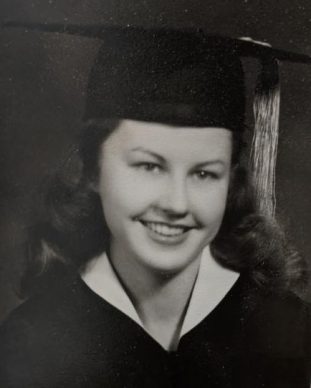
Mary L. Bradford Graduation
Virginia Sorensen was my [master’s] thesis subject at the U. [Virginia Sorensen was a Latter-day Saint novelist who received the Newbery medal for children’s literature in 1957.] Bill Mulder was my professor. He knew her personally and thought I should write about her. I first thought I would like to do a thesis of original poetry, and he didn’t think that was very good. He said, “Why don’t you write about a publishing Mormon author?” So I got acquainted with Virginia. I could interview her, get to know her and her family. It was a great subject. It lasted my whole life. I did finish my master’s thesis, and I wanted to write a book on Virginia. I have all the pieces, but I made a mistake. I thought I needed help and I decided two people could help me. Well, I didn’t do it, they didn’t do it. It’s too late now. Should have just done it myself. I don’t know why I didn’t. I’d been studying Virginia my whole life. I could sit down right now and do it if I had the energy.
Mary met her husband, Charles “Chick” Henry Bradford, at the University of Utah but they did not marry until 1957. Mary was 26.
You should have seen Chick on the campus. He was always with some girl. He dated a lot of wonderful women. One night we were at a fireside, and I was sitting next to him. Someone asked what we were going to do in the fall, and he said he was going to teach at BYU, and I said, “I’m going to BYU with Chick!” I loved his sense of humor. He could see the humor in anything. He had this angelic face. Returned missionary, been to Harvard, working on a dissertation. And we had the same value system.
We got down to BYU and my friend Barbara decided that we should get together –Chick and me. So, Barbara started calling me up and saying, “Get a ride to Salt Lake with Chick,” because I liked to go home on the weekends. I decided to call him, and we spent a whole evening talking.
A couple of weeks later, Barbara called and said, “I’m sorry, Chick just got engaged.” I said fine. A month later she called and said, “Call Chick for a ride.” I asked why and she said, “Well, they broke up.” So he was engaged before, but so was I! We started dating after that and decided to do what Lowell Bennion suggested – have a secret engagement. Get used to the idea before you let anyone into it. [Lowell Bennion founded the Institute of Religion at the University of Utah, and authored several books about the Church.]
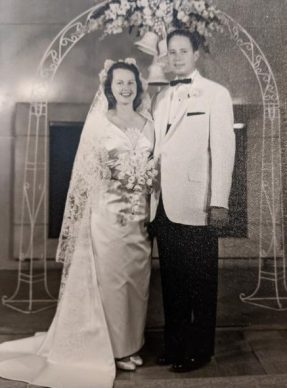
Mary & Chick Bradford Wedding
When Chick proposed to me, we were driving down Main Street and he said, “I see no reason why we shouldn’t get married.” I said, “I don’t either!” Then he didn’t say anything about it for a couple of weeks. I thought maybe I misunderstood. Then we went up to Emigration Canyon, and he showed me this little box with a ring and he slammed it shut and kept talking. I said, “Did you mean for me to have that?” He said, “Oh yeah.” This was the 4th of July so he lost his independence on Independence Day.
My father had kind of a woman’s intuition, more than Mother. When I started dating Chick, Dad started staying up waiting for me, which he hadn’t done for years. I said, “Why are you up, Dad?” And he said, “Because I think this is it. I think he’s it.” Mother was worried about it because he was crippled. [Chick had Facioscapulohumeral Muscular Dystrophy, a genetic disorder that causes progressive muscle degeneration, atrophy, and weakness.] She got over it once she knew him better. But Dad had a real knack.
After we were married, we moved to Arlington, Virginia. That ward was wonderful with a lot of couples like us, same age. We’d all left our families behind in Utah, so we depended on each other. It was great. Chick and I had a dream of building a home in Provo. We even owned a lot in Indian Hills. We thought we’d stay three years in DC and go back and build a house. I got homesick enough that we did go back to Utah. But then Senator Wallace Bennett called and said we have a great new job for you, so we went back to DC. I realized we loved it in DC and we didn’t want to go back to Utah anymore.
I figured out how to have a teaching career while we had kids. I taught writing classes and some speech classes to accountants from the GAO (Government Accountability Office). The head guy there was in our ward and he decided they should write better reports, so he had me come up and tell him what course I would do. I designed it by looking at some reports. In the class, I pointed out their report troubles and what to do with them. One of the guys leaned in and said, “Mrs. Bradford, if there’s anything you need to know, I can help you.” I thought, “Oh, I’ve found a writer!” I thought it was a comedic thing. He apparently didn’t want me giving courses and I think he was going for intimidation.
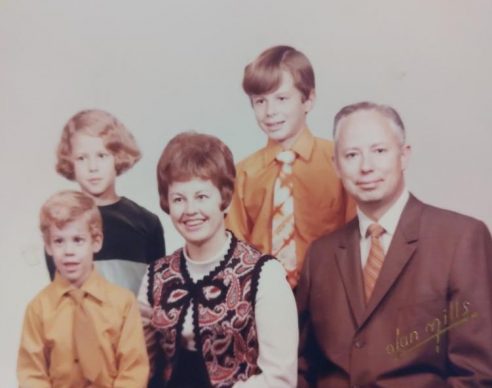
Mary & Chick Bradford and Their Young Family
I did it for about twelve years. Started with the GAO and other agencies came along — Interstate Commerce Commission, American University. They thought it would be good to catch students going into government and teach them how to write. We had weekend courses to write memos, reports, proposals… and I used poetry. I used the Jabberwocky: “T’was brillig, and the slithy toves did gire and gimble in the wabe!” I used that to talk about sentence structure. The word choices are something else, but you have to have a subject, verb, object, and stuff. You can use nonsense words in your writing and still get along. Of course, their sentence structure was like a freight train! They had to go back and learn how to write a decent sentence.
I went around the country as a government consultant to teach classes. They were usually three- or four-day seminars. It was a good part-time job. I could tell them I needed to be home with the kids and be there when they got home from school. Can’t do that now. They hadn’t had this type of consultant before, and they let me do what I wanted. When I went out of town, I would hire a Mormon couple to stay with the kids. Chick used to call me in the daytime and say, “What are you doing?” And I’d say, “What do you mean, what am I doing?” So one time I said, “Why don’t you stay with the kids for the weekend?” I called him while I was away and he’d been home with the kids, and he said, “Do you know what I had to do today?!” I said, “Yes, I do!” He never called and asked what I was doing again.
I still had a dream of being a writer, but I didn’t know how that would look. Then, in my forties, I took over as editor of Dialogue. [Dialogue: A Journal of Mormon Thought was the first independent journal in Mormon Studies. The journal has not shied away from publications on some of the difficult and controversial issues in Latter-day Saint history and doctrine, which made it somewhat controversial to more orthodox members. However, the editorial boards and contributing authors have been mainly scholars and writers who are actively participating members of the Church.]
I’d always loved Dialogue but I never expected to be editor. Gene England had founded Dialogue and put me on his staff – I knew Gene in college. He was at the U, and the summer before my marriage, I had lunch with him and his wife on campus and he told me the idea he had for a journal. I said, “Well, find me and put me on staff and do it.” And of course, we moved to Washington not long after that and I heard that he was starting this journal, so I called him up and asked to be on the staff. And that certainly led to a lot of wonderful experiences. Then in 1976, Bob Rees said he needed to pass it on to me.
I took Chick out to dinner and said if he didn’t want me to do it, I wouldn’t. He refused to say anything. “It’s up to you, I’ll support you,” he said. But I knew it was going to be a big hassle because he was the bishop of the Arlington Ward and the bishopric business was upstairs. Dialogue was downstairs. Our kids said, “The Celestial Kingdom was upstairs, and the Terrestrial Kingdom—Dialogue—was downstairs .”
When we had the book signing for one of my books out in Utah, the publishers asked my son Scott some questions about living with me, the bishopric, and Dialogue in the same house. Scott said, “My parents loved each other, so it was fine.” I remember that.
What are your favorite Dialogue issues and why?
When we first got it, Dialogue was almost gone because it didn’t have any subscribers. So we stayed up all night typing it up, sent out a little brochure, and people came back. So I think we can be credited with saving it. I thought we were transitional. We’d just keep it going until somebody would come along to really take it over. We ended up with a shelf of very good issues that people worked hard on and I’m really proud of. It was a good crew. We worked with them the whole time and didn’t lose anybody.
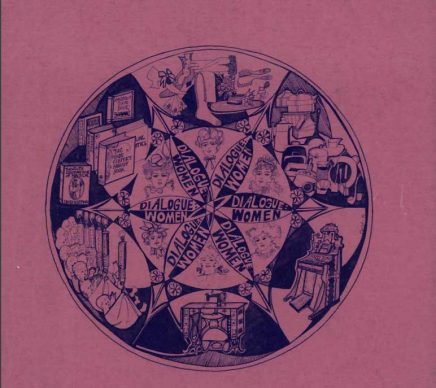
Dialogue Pink Issue
We did the red one on Nauvoo – the history of the Church there, as well as the restoration of the historic sites in the 1960s. It’s one of my favorites. Followed up with a pink issue on women. One section was photos of Mormon women doing things they aren’t usually known for, like Didi Willis remodeling her house. Then we had one woman with her dance concerts. We concentrated a lot on women in the arts, which I liked. We had a lot of good stuff in there.
And the Sonia Johnson issue. [Sonia Johnson was excommunicated for her vocal political support of the Equal Rights Amendment to the U.S. Constitution.] I interviewed her. I went to her house and it looked like mine – same color scheme, same stuff on the fridge, you know. She seemed like somebody I knew from way back. I think she was in a study group with me at one point. One time, she asked, “Why did the Lord decide that women couldn’t speak in church?” And I said, “What makes you think the Lord decided this?” She had a really black and white mind, thought the Lord had done it. So when the Dialogue issue came out, I heard that several of her followers subscribed who hadn’t before. But she didn’t like it because I emphasized her husband. She didn’t want him in it, but she followed her husband around the world with his job and had finally had enough. I thought that was important to the story. I tried to maintain a neutral voice as an editor.
People thought I had joined “Mormons for ERA” because I was friends with a lot of them. I had friends on both sides of the issue. I also interviewed the bishop who excommunicated Sonia Johnson, but he wouldn’t let me publish it. He said he’d like to do it but had to find out if “they” would let him do. So that’s when we knew for sure that he wasn’t offering any information.
There was the sex issue. The half-eaten apple [on the cover] was Greg Prince’s idea.
I want all my grandchildren to read the Black issue, of course. I wasn’t the editor, but I had a lot to do with it because I knew Lester Bush and Larry Bush. They were in the ward next to ours and knew about my work with Dialogue before I was the editor, so they came to talk to me about it. They had this bound copy of research on Black people and wanted me and my brother Dennis Lythgoe to write it up and publish it in Dialogue. I decided that Lester would make a better co-editor. He was great. His research skills were amazing. I looked it over and said, “Why don’t you do it? I’ll see that it gets in.” So that’s what we did and it was really ground-breaking.
Larry and I did some articles together for the Ensign for the opening of the DC temple and one on the history of Mormons in Washington. But they didn’t want to publish an article by a man and a woman who weren’t married to each other. So they divided it up and put his name on part and my name on the other. When we were working on the article, I talked to the editor of the Ensign and asked him about publishing Dialogue people in the Ensign and he said it’s okay if you’re not the editor. I had just signed on to take it over! So we published in the Ensign just before I took over Dialogue.
Dialogue was a great arrangement for me. I loved working on it while we raised our kids. They were growing up and leaving the nest. I stopped working on Dialogue in 1982 at age 52. I had other books I wanted to work on.
My next project was Mormon Women Speak in 1983, after Dialogue. I started that because I wanted to get some articles for Dialogue from women. That became the first Mormon women’s personal essay book that wasn’t published by the Church, I guess. I thought it was just something I could do for Dialogue. I didn’t realize it would become its own book later on.
Then Chick died when I was 61. He died on his birthday, December 11, 1991. We were married 34 years. Didn’t quite make it to 35. I was not expecting to be a widow, so that was bad. It was hard to have hopes and dreams and plans as a widow. What am I going to do next? I did start to have grandchildren. Multiple grandchildren in the 90s. I tended to them and we all cried the whole time.
My friends decided it would be good for my grieving to go to Ireland with them. Good place to go. I got in with the Irish friends and went to Ireland, so I also attended Catholic church for a while.
Are you more comfortable in the Church or less comfortable than you were twenty years ago? Fifty years ago?
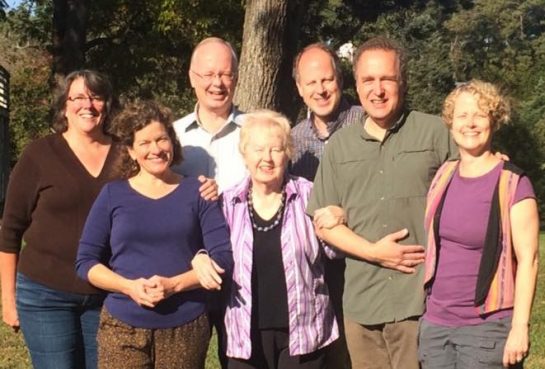
Mary L. Bradford with Her Children and Their Spouses
It comes and goes. Fifty years ago, in the 1960s in the Arlington Ward, I was quite happy. Chick became the bishop soon after we moved there. I loved the church; it was fun with a lot of great friends our same age. I loved my callings—mostly teaching Gospel Doctrine and Relief Society. We had some great lessons, lots of literature lessons. There wasn’t a lot about church that made me uncomfortable at the time, but some people thought I was a little uppity. I should’ve been having more kids instead of trying to write things, you know. I “only” had three kids. But it was a good ward. I was happy in the Church. They gave me lots of support.
Then 20 years ago, it was about 1995, I was 65. I was very uncomfortable. Chick had passed away. I was a widow. Still living in Arlington, but Chick was not with me anymore. That changed things. At first I thought I had to move away, but I got good advice not to do that. Don’t make too many decisions. So I stayed from when he died to 2001 or 2002. I rented out the basement and always had a bunch of different people coming to stay.
In 2002, I moved to Leisure World [a retirement community in the DC metropolitan area]. It was too quiet. “The grave is a fine, quiet place, but none, I think, do there embrace.”
I didn’t really attend my ward there. Being single at church made it different. I realized how hard it is for single people. I’ve spent over fifty years single, so I know what it’s like. I was a “special interest” at BYU – an unmarried adult when I was an instructor there. People at BYU thought I was going to church in Salt Lake. Salt Lake people thought I was going at BYU. I was really inactive because I felt out of it and left out. And that happened again as a widow. Well, as a widow I was active, but not really. I’d go to church but once in a while. Then I shifted to [my daughter] Lorraine’s ward in Sterling, Virginia. I go every week now. It’s important to feel part of the family, but it’s easier to feel part of the family when you bring a family to church with you.
You’ve discussed some regrets—some unfinished work. What do you consider your greatest accomplishment?
My children. I don’t really take full credit, though. I’m really pleased with all my kids and grandkids and the choices they’ve made.
I’m quite proud about the books I’ve written. I think they’ve turned out well. That Bennion book was really wonderful [Lowell L. Bennion: Teacher, Counselor, Humanitarian]. Brother Bennion was happy with it, so that’s important. His son told me he kept looking through it, and he was reading it again the day he died. People loved him and were glad to have me do it, so it was a good project.
But it turned out publishing it was another matter. People say if you’re doing something really good, it builds up a big shadow, and the shadow will try to get you. I found that out. I had no trouble writing the book because people loved it and loved him. But suddenly when it came to publishing it, there was all this trouble. So Dialogue finally published it, which I thought was right because he liked Dialogue and he helped us get going. It ended up being a really nice volume. [It won the David W. and Beatrice C. Evans Biography Award in 1995 and the Mormon History Association Best Biography Award in 1996.]
I’m also proud of my book of essays, Leaving Home, and my recent one Mr. Mustard Plaster. And my poetry book, Purple, which had limited circulation. About 300 people read that. I’m proud of my unpublished writings, too. I’ve written lots of poems. My Irish novella, The Harp. [This was published in 2020, the year of Mary’s 90th birthday.] There’s a collection of poems, some essays that I’ve half-finished, and the various piece of the Virginia Sorensen stuff.
I also really value the friends I’ve made and people I’ve connected with. Some prominent, some unknown. I couldn’t go on without the people in my life. I’ve been lucky. Plenty of people went through our house, staying there. Brother Bennion always said, “People count the most.” People I worked with on Dialogue were great. I always had lots of friends growing up, people in the neighborhood, and cousins were important to me.
What advice do you have for your grandchildren that will lead toward happy families?
Get an education. Don’t marry too soon. Learn how to think, whatever you do. If it takes a master’s degree, fine. But learn how to figure out what’s going on. I learned how to think, especially about my faith, from Lowell Bennion at the Institute of Religion.
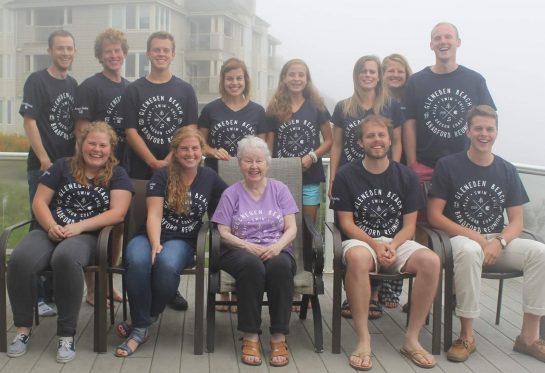
Mary L. Bradford and Her Grandchildren
I think having a family that plays together, discusses things, talks openly… My family would sit around and talk about what was happening to us. We always had a time we’d report on what we were doing, school, friendships, fears. I learned to do that and Chick didn’t. He was uncomfortable with it. Be willing to talk to your family about your problems. For a while, Chick was quite unhappy with me for wanting to do that. He didn’t think he should unload his troubles on others – just grin and bear it. Although I don’t think he was uncommunicative. He did love to talk about everything. He would sometimes say what subjects are off-limits: the Republican party [Chick was a Republican and Mary was a Democrat]. Sex. I overrode that actually. The Church—he didn’t want people bad-mouthing the Church, though. That was a common phrase of his. Anytime we disagreed it was “bad-mouthing!” But that was all in fun. He was open to real discussions.
My other advice is to read a lot. Read a lot, learn to think, get educated, and communicate with each other about your problems.
Who has most inspired you in your life?
Well, of course my parents. Lowell Bennion and Esther Peterson. Virginia Sorensen.
I met Esther, Virginia’s cousin, when I moved to Washington. She worked for a few presidents at the White House, and I got to know her quite well. They wanted her to write her biography. Some guy was going to write it for her and she didn’t like him. She said why didn’t I do it? That would have been great. I worked out a plan where I would interview her and write it up, about once a week. But then I guess people got wind of it and no one knew me. Why was I doing this? She ended up writing her own book and dictating it to her secretary. It came out the same time as my Bennion book. But I really admired Esther.
What matters most?
My family! I’m so lucky! I thought when Chick died, it was all over. But it wasn’t because I have such great family. My three kids. Four grandchildren, just barely, were born before Chick died. Eight more arrived after. I’m so lucky.
At A Glance
Name: Mary Lythgoe Bradford
Age: 91
Location: Arlington, Virginia & Provo, Utah
Marital History: Widowed
Children: 3 -Steve, Lorraine, Scott
Occupation: Writer
Convert to the Church: n/a
Schools Attended: Bachelor’s degree and master’s degree in English, University of Utah
Languages Spoken At Home: English
Favorite Hymn: I Stand All Amazed
Interview produced by Allie Bradford Brown
